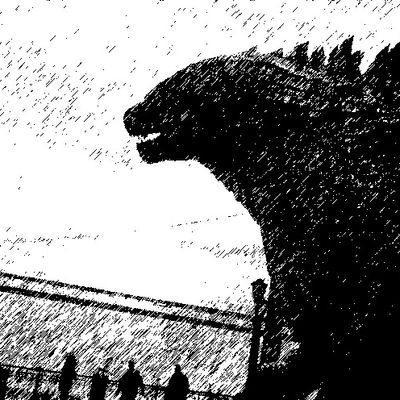
On May 11, the Godzilla: All Art Attack show opened at the Creature Features gallery in Burbank, California. And amid the pieces, which included an ad for a fake Godzilla-themed breakfast cereal and another depicting Godzilla as the Virgin Mary (er, okay), were three pieces instantly recognizable to any Godzilla archeologist. They are subtle and easy to overlook: three smallish sketches of a sleeker, more naturalistic version of the monster, etched in black and white by Eisner-winning comic-book artist Ricardo Delgado. What makes these sketches so special is that they were produced for a version of Godzilla that never saw the light of day. It did, however, get really, really close to happening.
By the early ‘90s, the Japanese Godzilla films weren’t performing like they should have been, and Toho, the studio behind the creature, thought that an American production might inject some fresh blood into the ailing franchise. An American riff on the character had been attempted a few years before, overseen by Monster Squad filmmaker Fred Dekker and Friday the 13th, Part 2 director Steve Miner, but the ambitious 3-D production ultimately faltered due to its high budget, technological challenges, and lack of studio interest.
Almost a decade after the Dekker/Miner attempt, TriStar had secured the rights to the character, thanks largely to the efforts of Henry G. Saperstein, whose company UPA had been responsible for the stateside release of a number of Godzilla films. The studio paid $400,000 for the rights to the character and retained an option for sequels. In a boastful Variety report, producer Cary Woods trumpeted the acquisition as, “a clear example of the kind of synergy that can exist when American producers and an American studio want to pursue something that is uniquely Japanese.”
TriStar tapped Ted Elliott and Terry Rossio, coming off their work on Disney’s smash hit Aladdin, to write the screenplay, and Jan De Bont, a former cinematographer whose debut feature as a director (Speed) was about to be released, to direct the project. A final draft of the screenplay by Elliott and Rossio, dated December 9, 1994, identifies the project simply as Godzilla.
The plot of this Godzilla was goofy and overstuffed and deliberately harkened back to the earlier entries in the franchise, and includes such hallmarks of the series as a malevolent alien force, a giant monster that mutates beyond control, and the depiction of Godzilla as a protector of the earth, not its destroyer. (Other nifty elements of the Elliott/Rossio script: giant killer bats, cattle mutilations, a secret organization known as the St. George Project, devoted exclusively to tracking down Godzilla, and a sleazy monster hunter serving as one of the main protagonists.) Godzilla’s foe was a nasty creature dubbed the Gryphon, with snakes for a tongue, catlike eyes, and giant wings. When the creature emerges from the earth, the script notes, “The nightmare has been born.”
And, truth be told, the nightmare was just beginning. As recounted on countless Godzilla fan sites, such as Kaijuphile, throughout 1994, the creative team was being assembled: Stan Winston, one of the visual-effects pioneers behind Jurassic Park, was hired to create a new, technologically advanced suit for the production (Winston, in turn, hired artists like Delgado and Mark “Crash” McCreery), and De Bont had dispatched crews to the Oregon coast to construct a Japanese fishing village that was to be destroyed in the film’s teaser trailer. Footage was shot (and occasionally finds its way online), but by the end of 1994, with a draft of the Elliott/Rossio script he was happy with and design work chugging along, De Bont found himself at odds with the studio over the film’s proposed budget. De Bont wanted $130 million, TriStar balked, and by the end of the year, De Bont had left the production to begin work on the sequel to Speed, which had come out that summer and grossed more than $120 million on a $30 million budget. De Bont’s dream of making a modern Godzilla movie that harkened back to those early classics would also evaporate with his departure.
TriStar tried to salvage the project and the following year hired British screenwriter Don Macpherson, a scribe who, just a few years earlier, had helped wrangle David Fincher’s troubled Alien 3 into semi-working order. The Macpherson draft features a number of notable changes, including setting the story in the vaguely futuristic year of 1999 and allowing the writer to cloak the entire film in a kind of apocalyptic doom. Two major characters were eliminated and the entire story condensed and simplified. Still: The studio was unconvinced.
In the summer of 1996, Independence Day, an earnest sci-fi epic built on hoary old tropes from ‘70s disaster movies, became a smash. And producer Dean Devlin and director Roland Emmerich were already at work on their follow-up. Before Independence Day had even come out, though, the duo had signed on for their next project: Godzilla. They threw out the Macpherson version of the script, as well as the original Rossio/Elliott draft, starting over with their own take on the material.
These days, few people talk about (or even remember) the ambitious, man-in-suit version of Godzilla that De Bont, Elliott and Rossio, Winston, and countless talented artists and technicians had toiled away on. Every now and then, evidence of its existence pops up: Delgado or McCreery sketches will go up on sale somewhere, and in 2007 a 43-inch model of the Winston Godzilla was auctioned off on eBay. It’s unclear whether or not the Jan De Bont Godzilla would have been better than the Emmerich/Devil project, but it sure as hell would have been different. Or, given that the project was such a deliberate throwback, maybe it would have just been more of the same.

